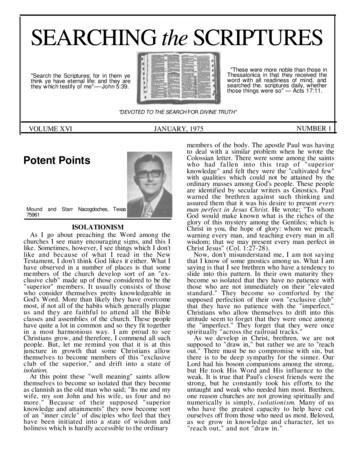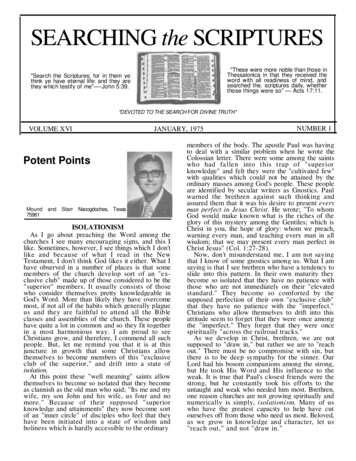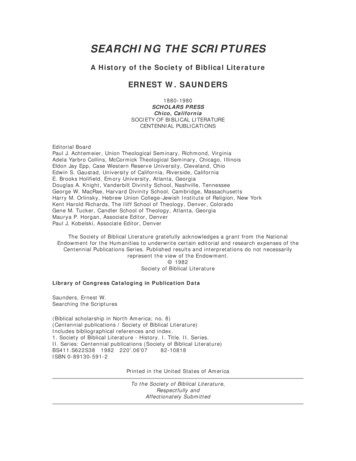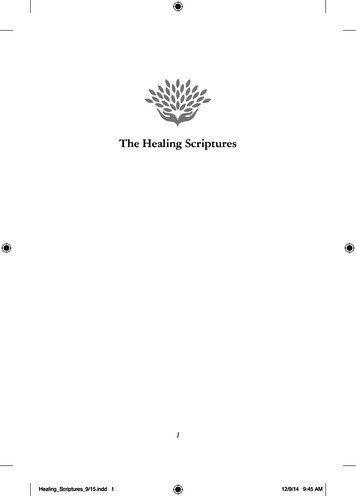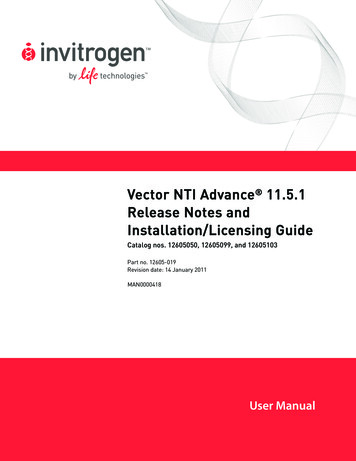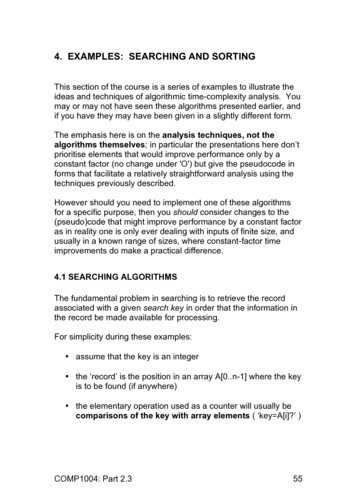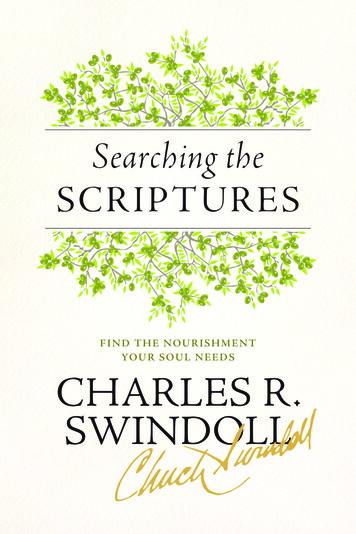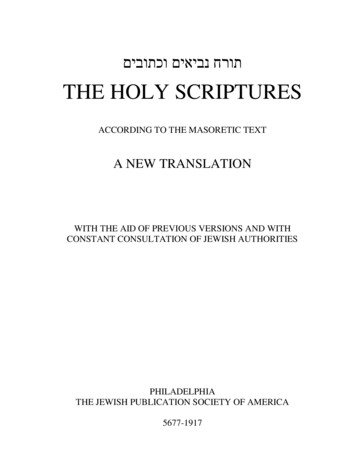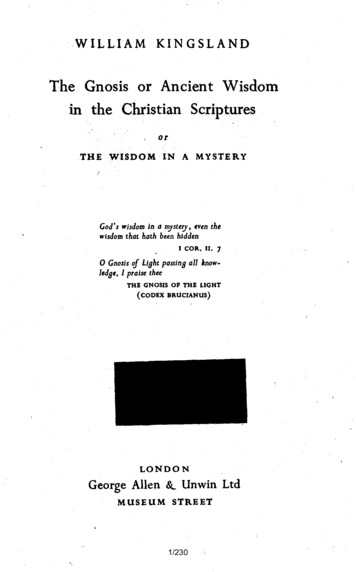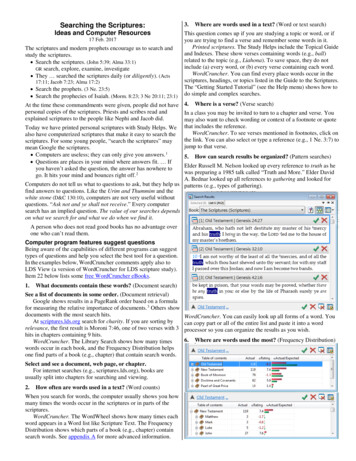
Transcription
Searching the Scriptures:Ideas and Computer Resources17 Feb. 2017The scriptures and modern prophets encourage us to search andstudy the scriptures. Search the scriptures. (John 5:39; Alma 33:1)GR search, explore, examine, investigate They searched the scriptures daily (or diligently). (Acts17:11; Jacob 7:23; Alma 17:2) Search the prophets. (3 Ne. 23:5) Search the prophecies of Isaiah. (Morm. 8:23; 3 Ne 20:11; 23:1)3.Where are words used in a text? (Word or text search)This question comes up if you are studying a topic or word, or ifyou are trying to find a verse and remember some words in it.Printed scriptures. The Study Helps include the Topical Guideand Indexes. These show verses containing words (e.g., ball)related to the topic (e.g., Liahona). To save space, they do notinclude (a) every word, or (b) every verse containing each word.WordCruncher. You can find every place words occur in thescriptures, headings, or topics listed in the Guide to the Scriptures.The “Getting Started Tutorial” (see the Help menu) shows how todo simple and complex searches.At the time these commandments were given, people did not have 4. Where is a verse? (Verse search)personal copies of the scriptures. Priests and scribes read andIn a class you may be invited to turn to a chapter and verse. Youexplained scriptures to the people like Nephi and Jacob did.may also want to check wording or context of a footnote or quoteToday we have printed personal scriptures with Study Helps. We that includes the reference.WordCruncher. To see verses mentioned in footnotes, click onalso have computerized scriptures that make it easy to search thethelink. You can also select or type a reference (e.g., 1 Ne. 3:7) toscriptures. For some young people, “search the scriptures” mayjumpto that verse.mean Google the scriptures.1 Computers are useless; they can only give you answers.5. How can search results be organized? (Pattern searches) Questions are places in your mind where answers fit. IfElder Russell M. Nelson looked up every reference to truth as heyou haven’t asked the question, the answer has nowhere towas preparing a 1985 talk called “Truth and More.” Elder Davidgo. It hits your mind and bounces right off. 2A. Bednar looked up all references to gathering and looked forComputers do not tell us what to questions to ask, but they help us patterns (e.g., types of gathering).find answers to questions. Like the Urim and Thummim and thewhite stone (D&C 130:10), computers are not very useful withoutquestions. “Ask not and ye shall not receive.” Every computersearch has an implied question. The value of our searches dependson what we search for and what we do when we find it.A person who does not read good books has no advantage overone who can’t read them.Computer program features suggest questionsBeing aware of the capabilities of different programs can suggesttypes of questions and help you select the best tool for a question.In the examples below, WordCruncher comments apply also toLDS View (a version of WordCruncher for LDS scripture study).Item 22 below lists some free WordCruncher eBooks.1.What documents contain these words? (Document search)See a list of documents in some order. (Document retrieval)Google shows results in a PageRank order based on a formulafor measuring the relative importance of documents. 3 Others showdocuments with the most search hits.At scriptures.lds.org search for charity. If you are sorting byrelevance, the first result is Moroni 7:46, one of two verses with 3hits in chapters containing 9 hits.WordCruncher. The Library Search shows how many timeswords occur in each book, and the Frequency Distribution helpsone find parts of a book (e.g., chapter) that contain search words.Select and see a document, web page, or chapter.For internet searches (e.g., scriptures.lds.org), books areusually split into chapters for searching and viewing.2.How often are words used in a text? (Word counts)When you search for words, the computer usually shows you howmany times the words occur in the scriptures or in parts of thescriptures.WordCruncher. The WordWheel shows how many times eachword appears in a Word list like Scripture Text. The FrequencyDistribution shows which parts of a book (e.g., chapter) containsearch words. See appendix A for more advanced information.WordCruncher. You can easily look up all forms of a word. Youcan copy part or all of the entire list and paste it into a wordprocessor so you can organize the results as you wish.6.Where are words used the most? (Frequency Distribution)
7.What words are found near search words? (Neighborhood)WordCruncher. After a wordsearch, you can see a NeighborhoodReport. The top part shows thewords before and after the searchword. The bottom part shows wordsfound near the search word. Thebetter “friends” are highlighted.Click on a column heading to sort.8.Ezra Taft Benson: In the scriptures there is no such thing asrighteous pride—it is always considered a sin. Therefore, nomatter how the world uses the term, we must understand howGod uses the term so we can understand the language of holywrit and profit thereby. (“Beware of Pride,” Ensign, May 1989)11. What was the Hebrew or Greek word and its meaning?The LDS Bible has HEB or GR footnotes that give alternatetranslations for about 1% of the original Hebrew or Greek words.With the English Parallel Bible in WordCruncher, you can seeHebrew and Greek words written with English letters and howthey were translated in the King James Bible. You can click on aHebrew or Greek word to see a brief or longer definition. You candouble-click on a word to see every place the word occurs. Seethe LDS View “Getting Started Tutorial” in the Help menu formore information.What were the actual search words?When you search using “All Forms” or wildcards (e.g., *ing), youcan see the actual search words by selecting Search VocabularyHebrew and Greek dictionaries. When you click on a Hebrew orReport from the menu with the Neighborhood Report (see above). Greek word (e.g., ’ĕlōhîm), you will see a brief definition fromStrong’s Hebrew or Greek Lexicon and how the word was9. Which phrases are repeated? (Phrase Compare Report)translated in the Bible. You will also see links to a pdf of BrownWordCruncher. While looking at a textDriver Briggs Hebrew and English Lexicon (BDB), or Thayer’swindow, you can select the PhraseGreek Lexicon where you will see longer definitions.Compare Report. This shows repeatedphrases in the different books, the samebook, or in parts of a book. Click on acolumn heading to sort.10. How are words used in scripture? (Search for contexts)Words change meanings over time. For example, when the Biblewas translated about 400 years ago, gay meant beautiful, fine, orcheerful. About 1950 gay began to refer to same-sex attraction orbehavior. Many common words (e.g., flatter, offend, men) havedifferent meanings now. President Benson’s talk on pride showedthe importance of learning the meaning of words “as contained inthe scriptures” regardless of how the words are used now.
12. What are the meanings of English words?Google: type define flatter to search for the definition. This willusually find modern meanings, not old meanings.Webster’s 1844. If you have downloaded this WordCruncherbook, you can click on an English word to see the meaning in thedictionary window. This dictionary is basically the same as the1828 dictionary, but with more technical words. Webster oftengave Bible examples for word meanings.(Shorter) Oxford English Dictionary (OED or SOED): Thisdictionary shows the historical meanings of words. It is veryhelpful when studying the scriptures and related books withmeanings from AD 1500–1850. The Book of Mormon manuscriptsand the 1830 edition appear to match the variations in grammarand word meanings found in English writings from the 1500s to1700s (e.g., 1611 King James Bible, Tyndale, Shakespeare),not 1830 American English. 4What is the opposite of ? For example, what is theopposite of faith in Christ? Doubt, fear, disobedience? Thescriptures often suggest word pairs (e.g., hard heart/broken heart,pride/humility, friend/enemy, love/hate, bitter/sweet, light/dark).Merism is a rhetorical term for a pair of contrasting words (suchas near and far, young and old, rich and poor, high and low, goodand evil, heavens and the earth, light and darkness) used toexpress totality or completeness. It is like referring to the twoends of a continuum (e.g., A to Z, alpha and omega) to describeeverything in between the two ends.The Lord inviteth all to come unto him black and white,bond and free, male and female; Jew and Gentile. (2 Ne 26:33)Definition: What is and is not meant? For example, as you lookat the colors below and move your eyes from left to right or frombottom to top, where does blue begin and end?13. How else could this be translated?A BYU New Testament instructor required his students to readeach assignment in the King James Bible (KJV) and at least oneother translation. Differences in translation suggest questions andimprove understanding. For example, Because the daughters of Zion are haughty, and walk with wanton eyes, walking and mincing [as] they go, and making atinkling with their feet: (KJV Isa 3:16) The women of Zion are haughty, walking along , flirtingwith their eyes, strutting along with swaying hips, withornaments jingling on their ankles. (NIV Isa 3:16)15. What verses contain more of these words?At www.blueletterbible.org you can see more than 10 EnglishFor language learning, it may be useful to look of the mostBible translations. The Old Testament translations are usuallyfrequent 50 words and to find verses with many of these words.based on the same Hebrew original as the KJV, but the NewYou might also look up all words ending in ing.Testament translations are often based on a Greek text that isWordCruncher. You can sort the WordWheel by frequency, add aabout 80% the same as the Greek text used for the KJV.Normal text filter, and search for the top 50 words (e.g., the, and).WordCruncher. You can open the LDS Scriptures in about 30While looking at the Search Results window, you can selectlanguages. Currently Spanish and Portuguese are the onlyLowest-Level Frequency Distribution Report. You can click onlanguages with an LDS Bible. If you open the scriptures in two or the “Hits” or “Unique” column header to sort the list. When youmore languages, you can look up a verse in one language and the select one of the verses, you will see that verse with top 50 wordsother language windows will automatically synchronize or showhighlighted in the window below. For example, “And they shallthe same verse (unless you pin a window). This facilitatesbe my people, and I will be their God:” (Jer. 32:38) consistscomparisons. For example, when you see LORD or host of heaven entirely of 11 out of the 50 top words.in the English Bible, you will see Jehová or ejército [army] delcielo in Spanish.14. What are “opposition” words with contrasting meanings? 16. Where has this verse been quoted or cited?“It must needs be, that there is an opposition in all things” (2 Ne2:11). A friend applied this to language by saying you don’t knowwhat a word means unless you know what it does not mean. Onemeaning of opposition is “placing one thing in contrast withanother” (SOED). Perception requires contrast. One cannot notice apolar bear in snow storm, or white letters on white background. Athesaurus suggests words with similar or opposite meanings.Before computerized scriptures were widely available, MostQuoted Scriptures (Kay Briggs, 1981) was a reference guide to over1,000 LDS scriptures referred to in talks by General Authorities.With a computer, it is easy to find many other scriptures insteadof relying on the most quoted scriptures.
At http://scriptures.byu.edu you can look up any verse of scriptureand see where it was cited by speakers (a) in LDS GeneralConference (1942 to present), (b) in the Journal of Discourses(1839–1886), and (c) in Teachings of the Prophet Joseph Smith.The year, conference, volume, page, and initials identify thesource and speaker. You can click on one to see the text.Alma 17:2-3 (13 A,69,TSM) (08 O,98,WDO)(01 A,75,JBW) (96 A,75,WML) (92 O,81,JEJ)(92 O,81,JEJ) (90 O,24,RKD) (90 O,27,HM)(89 A,23,REP) (86 A,63,TSM) (79 O,16,MGR)(75 O,26,MDH) (73 A,28,BRM) (69 O,94,TSM)(67 O,17,RLS) (61 A,34,HBL) (51 O,124,DLS)(191,JS)Alma 17:2-9 (16:57a,OP)Alma 17:3 (09 A,48,RMN) (92 O,83,AAL)(62 A,68,TBI) (148,JS) (155,JS)Alma 17:4 (288,JS)Alma 17:5 (02 A,32,RRS) (92 O,83,AAL)(89 A,23,REP) (32,JS)At https://www.lds-general-conference.org/ you can searchGeneral Conference talks (1850–now) and see word frequenciesand charts for each decade. This helps identify when words werebeing emphasized. For example, grace is mentioned morefrequently in the last 30 years. You can click on a decade to seethe words in context.18. What is omitted or not written?What priesthood office is not mentioned? Computers can helpus find possible priesthood titles and where they occur. But wehave to notice the absence of titles. What title(s) is missing?The high priest and elder have a right to officiate in all theseoffices [elder, priest, teacher, deacon] when there are nohigher authorities present. (D&C 107:10–12)Perhaps, this omission was considered before all stake quorums ofthe seventy were discontinued in 1986.What types of food or drink are not in the Word of Wisdom?It is interesting (a) to identify various types of plants, animals,foods, and drinks mentioned in Bible and modern literature, and(b) to see which ones are not mentioned in the Word of Wisdom.19. What do pronouns refer to?Pronouns like he, she, they, these, or those commonly refer to anoun or noun phrase used earlier. Plural pronouns refer to pluralnouns. Feminine pronouns refer to feminine nouns. Sometimes itis clear what a pronoun refers to. In the verse below, they clearlydoes not refer to the singular nouns man or Lord.Yea, flesh also of beasts and of the fowls of the air, I, the Lord,have ordained for the use of man with thanksgiving;nevertheless they are to be used sparingly; (D&C 89:12)Sometimes it unclear what a pronoun refers to.All grain is ordained for the use of man and of beasts, to be the17. What is the context of a verse?staff of life, not only for man but for the beasts of the field, andComputers make it easy to search for a verse containing a word orthe fowls of heaven, and all wild animals that run or creep onwords. They also make it easy to take words out of context.the earth; And these hath God made for the use of man only inSometimes this is fun.times of famine and excess of hunger. (D&C 89:14–15) First car accident: “They ran upon him with one accord”Does these refer to all four underlined words or phrases? Vegans(Acts 7:57).and vegetarians may assume these refers to beasts, fowls, and wild First smoker: “She lighted off the camel” (Gen 24:64).animals. For them, sparingly means “only in times of famine orSometimes words are taken out of context to change the meaning excess of hunger.” Others may assume these refers only to wildanimals which the Jews considered unclean, and that beasts andfor political or financial gain. For example, political opponentsquoted only the underlined words from a Mitt Romney speech in fowls earlier were to be used sparingly, not just in times of famine.2012: “I’m in this race because I care about Americans. I’m not20. Where do words appear in the scriptures?concerned about the very poor. We have a safety net there. If itInthe top right corner of the scripture window, (a) select theneeds repair, I’ll fix it.” 5 A movie ad quoted only the underlinedVocabulary Dispersion Report, (b) add a word filter to see onlywords from a movie review: “The credit sequence, with its jumpy Abram, Abraham, Isaac, Jacob, and Israel, and (c) set theframes and near-subliminal flashes of psychoparaphernalia, is“Calculation boundary” to Old Testament.a small masterpiece of dementia.” 6When we find a verse, computers make it easy to see versesbefore and after. This helps us understand the meaning of a verse.For example: “by grace are ye saved through faith not ofworks” (Eph. 2:8–9). When one looks up Paul’s other references tofaith and works, it is clear that he is referring to “faith in JesusChrist” and “the works of the law” of Moses (e.g., circumcision,dietary rules, Sabbath rules). Paul argued against JewishChristians who said Gentile Christians needed to keep the law ofMoses as taught by the rabbis (see Acts 15; Gal. 2). However, whenJames said “faith without works is dead” (James 2:20), he wasreferring to “good deeds” like feeding the hungry, not to theworks of the law of Moses. Paul also teaches people to do good,not “the works of the flesh.” (Gal 5:13–26)About 1400 years later, Martin Luther quoted Paul’s teachings onfaith and works as he argued against the seven sacraments (works)that the Catholic Church said were necessary for salvation. He andmany other Protestants accepted only two: baptism, sacrament.
21. What words occur only in the Book of Mormon?23. Other computer resourcesIn the top right corner of thescripture window, (a) select theVocabulary Frequency DistributionReport, (b) select Book of Mormonsection, (c) select the filter “Only inSection A,” and (d) click on theRecompute button.LDS View ScripturesLDS View is a version of WordCruncher that includes the LDSScriptures in about 30 languages. If you are interested in thescriptures as well as other LDS Gospel Library materials (seebelow) you can use WordCruncher or LDS.org.WordCruncher eBooksAfter you download WordCruncher at www.wordcruncher.com,you can download various eBooks. Webster’s 1844 dictionary canbe a helpful resource for scripture study. The following is a brieflist of free eBooks that can help one better understand thescriptures. When you go to the WordCruncher Bookstore, youwill see a brief description of these and other eBooks.LDS Gospel Library The Scriptures in about 30 languages. General Conference Addresses Teachings of Presidents of the Church manuals Institute Student Manuals: Old Testament to Pearl of GreatPriceFor a similar graphical report, (a)select “Word-Use Reports” fromthe top right corner of the SearchWindow, (b) select “Words usedONLY in reference,” and (c) clickon the “B of M” bar in the chart tosee the words in the top leftwindow. To zoom in, double-click on the “B of M” bar.22. Other WordCruncher reports and featuresThe Search window, Search Results window, and text windowslike the Scripture text window all have report buttons in the topright corner. Reports may have filters and sort options (e.g., clickon a column heading). If you have questions about a report, youcan press the F1 key or select Contents from the Help menu.WordCruncher LibraryLDS Authors Bradford, Gerald. Uncovering the Original Text of the Book ofMormon Faulconer, James E. Scripture Study: Tools and Suggestions ——. Romans 1 ——. Life of Holiness Nibley, Hugh W. Teachings of the Book of Mormon ——. Teachings of the Pearl of Great Price ——. Of All Things ——. When the Lights Went Out Parry, Donald W. Harmonizing Isaiah ——, ed. Echoes and Evidences of the Book of Mormon ——, ed. Isaiah in the Book of Mormon ——, Poetic Parallelisms in the Book of Mormon, ——, ed. Temples of the Ancient World ——, ed. Temple in Time and Eternity Pinnock, Hugh W. Finding Biblical Hebrew and OtherAncient Literary Forms in the Book of Mormon Ricks, Stephen D., ed. Allegory of the Olive Tree ——, ed. King Benjamin’s Speech ——, ed. Warfare in the Book of Mormon Reynolds, George, Commentary on the Book of Mormon Reynolds, Noel B., ed. Early Christians in Disarray ——. Book of Mormon Authorship Roberts, B. H. Comprehensive History of The Church Skinner, Andrew, ed., Third Nephi: An Incomparable Scripture Smith, Hyrum M. Doctrine and Covenants Commentary Smith, Joseph. Documentary History of the Church ——. Teachings of the Prophet Joseph Smith Sorenson, John L. Mormon’s Map ——. Ancient American Setting for the Book of Mormon ——, ed. Rediscovering the Book of Mormon Taylor, John. Life and Writings of Talmage, James E. Religious Writings (includes Jesus theChrist, Articles of Faith, and more) Thorne, Melvin J. Pressing Forward with the Book of Mormon
Welch, John W. Illuminating the Sermon at the Temple ——, ed. Legal Cases in the Book of Mormon——, ed. Reexploring the Book of MormonWoodruff, Wilford. Life and Writings of Joseph Smith’s Translation (JST) Electronic Library Early LDS Periodicals (e.g., Times and Seasons, Messengerand Advocate, Evening and Morning Star, Elder’s Journal) Non-LDS AuthorsEdersheim, Alfred. The Temple——. Life and Times of Jesus the Messiah——. Sketches of Jewish Social LifeFalk, Ze’ev W. Hebrew Law in Biblical TimesFarrar, Frederic W. Life of ChristFreeman, James M. Handbook of Bible Manners and CustomsGinzberg, Louis. Legends of the JewsHatch, Edwin. Influence of Greek Philosophy and Usagesupon the Christian ChurchJosephus (Jewish historian, AD 37–100), Writings of JosephusMountford, Lydia. Writings of Lydia Mountford [Includes twobooks about the Bible from a Middle Eastern perspective.] Roberts, Early Christian Fathers (ANF, NPNF) Schaff, Philip, ed. Creeds of Christendom Webster, Noah. Dictionary of the English Language (1844)Church Internet ResourcesAt www.lds.org you can find many resources by clicking on theResources button near the top right. You can also go directly tothese resources: scriptures.lds.org , mobile.lds.org,institute.lds.org, seminary.lds.org, manuals.lds.org,magazines.lds.org, lds.org/media-libraryBYU Internet Resourcesmi.byu.edu is the Maxwell Institute website. It has online versionsof many books they have published including those publishedunder the name of F.A.R.M.S. (e.g., Hugh Nibley’s writings).Many of these books are also available as WordCruncher eBooks(see brief list above). You can download some of these books asPDFs (e.g., Donald Parry, Visualizing Isaiah).scriptures.byu.edu lets you see and read where scripture verseswere cited in general conference talks (1942–present), in Journalof Discourses (1839–86), and in Teachings of the Prophet JosephSmith. See examples in item 15 above.speeches.byu.edu lets you read, watch, or listen to BYUdevotionals and firesides given by Church leaders, BYUpresidents and professors, and distinguished campus visitors.rsc.byu.edu is the Religious Studies Center’s website thatprovides online access to their publications.edl.byu.edu/webster lets you use a browser to access Webster’s1844 dictionary. This dictionary is also a WordCruncher eBook.byustudies.byu.edu provides access to scholarly articles on topicsof LDS interest that have been published in BYU Studies.Other Internet Resourceswww.ldsgospeldoctrine.net: This has links to several websiteswith free notes or handouts created by a variety of GospelDoctrine instructors to help with discussions of the scriptures.www.blueletterbible.org: This has 16 English Bible translations.Differences in translations suggest questions or improveunderstanding of old English words.www.fairmormon.org gives faithful answers to critical questions.www.mormoninterpreter.com is A Journal of Mormon Scripturewith many past and present BYU scholars on the board.bookofmormoncentral.org provides free access to Book ofMormon research and scholarship.Book of Mormon GeographyThe Church has no official position on the location of Book ofMormon lands. Three proposals are: Mesoamerica (Mexico andGuatemala), the U.S. Heartland or Great Lakes (East of theMississippi), and Baja California. To find other proposals, searchonline for Book of Mormon geography. Mesoamerica: fairmormon.org, bmaf.org, poulsenll.org Heartland: ancientamerican.com, firmlds.org Baja: achoiceland.com These and several others: bookofmormononline.netJewish Traditions, Customs, and Perspectivejewishencyclopedia.com contains the 12 volume JewishEncyclopedia published between 1901 and 1906. It provides aJewish perspective about people and events in the Old Testament.donna-connections.blogspot.com is a blog by an LDS author andspeaker that includes interesting insights based on the languageand culture of the Bible.engediresourcecenter.com has resources to help people understandthe Old and New Testaments in their Hebraic and Jewish context.Ancient and Modern Templestemplestudy.com is an LDS website about ancient and moderntemples.templeinstitute.org is a Jewish website about the Jewish temples.It includes art, photos, and video to help one visualize andunderstand ancient temple worship.An interesting article describes old Catholic traditions and rituals.This helps to understand and appreciate restored temple worship. Marcus von Wellnitz, “The Catholic Liturgy and the MormonTemple,” BYU Studies 21:1 tle 5448
Appendix A:Word CountsFrequency Distribution: At the bottom of each search you cansee the total number of words in each section (e.g., OldTestament) of the text. This “Total” count includes all normalwords in all Word Lists (e.g., Scripture, Preface, Headings). Itdoes not count punctuation, verse numbers, subwords, ortagwords. If you cannot see the “Total” column, right-click on acolumn heading and select Total.Word Counts for a Word listSearch for all words in a Word list (e.g., Scripture Text): Typean asterisk in the Find box and press Enter to see the FrequencyDistribution. This type of search gets the same results for a Wordlist regardless of which search options (e.g., All Forms) areselected. However, it also includes all “words” (e.g., punctuationmarks, subwords, and tagwords) that are in the WordWheel.Therefore, in the Frequency Distribution, you will see that theActual column is greater than the Total column.Search for all “normal” words in a Word list: To omitpunctuation marks or other “words” from your search, add aWord-Type filter and put a check by “Normal text.” If you haveversion 7.1.56 or later of WordCruncher/LDS View, adding thisfilter will shut off the All Forms and Ignore Type search options.If you now search for all words (“*”), the Actual column will beless than the Total column which includes prefaces and headings.[The Actual and Total column are the same when you search “Alltext” for “Normal words.”]Search for all words in part of a book (e.g., Alma): Set thebounds (e.g., Table of Contents). Type an asterisk in the Find boxand press Enter to see the Frequency Distribution. This type ofsearch gets the same results for a Word list regardless of whichsearch options (e.g., All Forms) are selected. However, it alsoincludes all “words” (e.g., punctuation marks, subwords, andtagwords) that are in the WordWheel. Therefore, in the FrequencyDistribution, you will see that the Actual column is greater thanthe Total column.
To find the most frequently used words in this part of the text,select the Search Vocabulary Report to see an alphabetical list ofall words in the Search Results.Endnotes1234To sort the list by frequency, click on the Frequency columnheading.Section Word CountsVocabulary Frequency Distribution Report (Book Report):This report can show word counts for each word in up to FOURsections. You can also select different Word lists (e.g., Preface,Heading, Scripture). In the bottom left corner, you can check“Ignore case” or “Ignore diacritics.”56Pablo Picasso, 1881–1973; c. 1964.Jason Fried, “A Conversation with Innovation Guru ClaytonChristensen,” ipedia.org/wiki/PageRankRoyal Skousen, “The Archaic Vocabulary of the Book of Mormon,”Insights 25 (2005):2–6.Stanford Carmack, “A Look at Some ‘Nonstandard’ Book of MormonGrammar,” Interpreter 11 (2014):209–262.Stanford Carmack, “Why the Oxford English Dictionary (and notWebster’s 1828),” Interpreter 15 (2015):65–77.Daniel Peterson, “Defending the Faith: The very surprising languageof the Book of Mormon,” Deseret News, Aug. 21, 2014.Mitt Romney interview with Soledad O'Brien on CNN, Feb. 1, 2012http://en.wikipedia.org/wiki/Fallacy of quoting out of context
Searching the Scriptures: Ideas and Computer Resources 17 Feb. 2017 . The scriptures and modern prophets encourage us to search and study the scriptures. (John 5:39; Alma 33:1)Search the scriptures. GR. search, explore, examine, investigate They searched the scriptures daily

